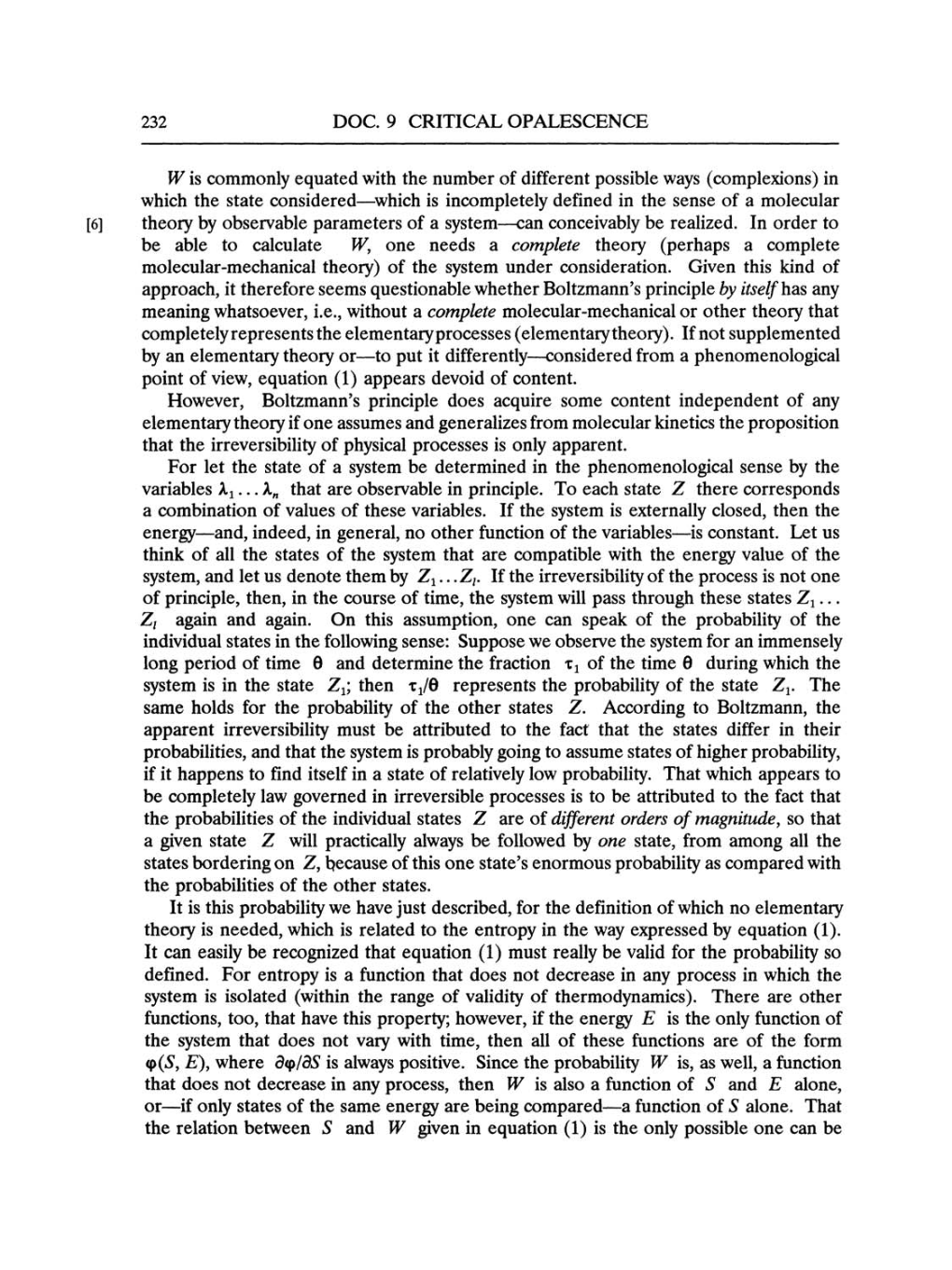232
DOC.
9
CRITICAL OPALESCENCE
[6]
W
is
commonly
equated
with
the number of different
possible ways (complexions)
in
which
the
state
considered-which
is incompletely
defined
in
the
sense
of
a
molecular
theory
by
observable
parameters
of
a
system-can
conceivably
be realized.
In order
to
be
able to calculate
W,
one
needs
a complete
theory (perhaps
a
complete
molecular-mechanical
theory)
of the
system
under consideration.
Given this kind
of
approach,
it
therefore
seems
questionable
whether Boltzmann's
principle
by
itself
has
any
meaning whatsoever,
i.e.,
without
a complete
molecular-mechanical
or
other
theory
that
completely represents
the
elementary
processes
(elementary
theory).
If
not
supplemented
by an
elementary theory
or-to
put
it
differently-considered
from
a
phenomenological
point
of
view,
equation
(1)
appears
devoid
of
content.
However,
Boltzmann's
principle
does
acquire some
content
independent
of
any
elementary theory if
one assumes
and
generalizes
from
molecular
kinetics
the
proposition
that the
irreversibility
of
physical
processes
is
only
apparent.
For let the
state
of
a system
be determined
in
the
phenomenological
sense by
the
variables
A1
...
Xn
that
are
observable
in
principle.
To each
state
Z there
corresponds
a
combination of
values
of these
variables.
If the
system
is
externally
closed,
then the
energy-and,
indeed,
in
general,
no
other function of the
variables-is
constant.
Let
us
think of
all
the
states
of the
system
that
are
compatible
with
the
energy
value
of the
system,
and let
us
denote them
by
Z1...Zl.
If
the
irreversibility
of the
process is
not
one
of
principle,
then,
in
the
course
of
time,
the
system
will
pass
through
these
states
Z1...
Zl
again
and
again.
On
this
assumption, one can speak
of the
probability
of the
individual states in
the
following sense:
Suppose
we
observe
the
system
for
an immensely
long
period
of time
0 and
determine the fraction
X1
of the
time 0
during
which
the
system
is
in
the
state
Z1;
then
x1/0
represents
the
probability
of the
state
Z1.
The
same
holds
for the
probability
of the other
states
Z.
According
to
Boltzmann,
the
apparent
irreversibility
must
be attributed
to
the
fact
that the
states differ in
their
probabilities,
and that
the
system
is
probably
going
to
assume
states
of
higher probability,
if it
happens
to find
itself
in
a
state
of
relatively
low
probability.
That
which
appears
to
be
completely
law
governed
in
irreversible
processes is
to be
attributed
to
the
fact
that
the
probabilities
of the
individual states
Z
are
of
different
orders
of
magnitude,
so
that
a given
state
Z
will
practically always
be
followed
by
one
state,
from
among
all
the
states
bordering on
Z, because
of
this
one
state's
enormous probability as compared
with
the
probabilities
of the other
states.
It
is
this
probability
we
have
just
described,
for the definition of
which
no
elementary
theory
is needed,
which
is
related
to
the
entropy
in
the
way
expressed
by
equation
(1).
It
can
easily
be
recognized
that
equation
(1)
must
really
be valid
for the
probability
so
defined. For
entropy
is
a
function that does
not
decrease
in
any
process
in which
the
system
is
isolated
(within
the
range
of
validity
of
thermodynamics).
There
are
other
functions, too,
that
have this
property; however,
if
the
energy
E
is
the
only
function of
the
system
that
does not
vary
with
time,
then
all
of these
functions
are
of the
form
p(S,
E),
where
dy/dS
is
always positive.
Since
the
probability
W
is,
as
well,
a
function
that does
not
decrease
in
any
process,
then
W
is
also
a
function of
S and
E
alone,
or-if
only
states
of the
same energy are being
compared-a
function of
S
alone.
That
the relation between
S
and
W
given
in
equation
(1)
is
the
only possible one can
be
